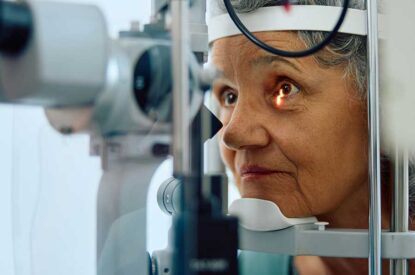Selective Laser Trabeculoplasty (SLT)
Selective Laser Trabeculoplasty (SLT) is a form of laser treatment that lowers the pressure and helps glaucoma patients by applying laser energy to the eye’s drainage tissue, starting a chemical and biological change in the tissue that can lead to better fluid drainage out of the eye.
It’s called “Selective” because the laser selectively affects the pigmented tissue in the eye without causing collateral damage to other parts of the tissue. This advantage makes SLT repeatable in the proper setting.
This video provides a brief introduction to selective laser trabeculoplasty (SLT) for treating open-angle glaucoma.
Selective laser trabeculoplasty (SLT), often a first-line treatment for Open-Angle Glaucoma, can also be effective in patients already on eye drops. SLT uses low levels of laser light to improve drainage of intraocular fluid through the natural drainage pathway out of the eye. For most eyes this improved drainage helps lower eye pressure and a single treatment’s effect may last 2 to 3 years, and sometimes longer. Since SLT leaves the drainage canals intact, it can be repeated if the initial treatment was effective. Minor self-limited inflammation follows SLT and may aid in the eye pressure lowering effect.
Some patients can have their eye pressure controlled with SLT alone. Others require glaucoma medications also or incisional surgery in the operating room.
What to expect from SLT treatment:
- SLT is performed in an outpatient setting, frequently in the doctor’s office.
- Your doctor will use special eye drops to numb your eye. Then, your doctor will have you sit at the laser and place a special lens with contact lens gel on your eye to help direct the laser light onto the drainage canals in your eye.
- You will hear a series of clicks and see bright lights, like a camera flash, as your doctor performs the procedure. You may feel a slight tingling sensation, but the procedure is nearly painless.
- SLT takes about 5-10 minutes.
- At the end of the treatment, the lens is removed and your vision will be blurry until the thick contact lens gel is rinsed off.
- After the treatment, you should take it easy for a day or two and then return to your daily routine.
Direct Selective Laser Trabeculoplasty (DSLT)
Direct Selective Laser Trabeculoplasty (DSLT) is a newer, non-contact laser treatment that uses automated, image-guided technology to deliver laser pulses to the eye’s drainage tissue, the trabecular meshwork. The procedure requires placement of an eyelid speculum which is a device that holds the eyelids open. It is faster than traditional SLT and does not require a contact lens on the eye.
SLT Clinical Studies
From the Glaucoma Laser Trial in 1995 to the more recent LiGHT clinical trial, large clinical studies have shown initial laser for open-angle glaucoma to be equivalent or even superior to medications. A 2019 report in “The Lancet” said the laser treatment selective laser trabeculoplasty, or SLT, should be offered as first-line treatment for glaucoma, replacing the prescribing of pressure-lowering eye drops. The study revealed that SLT is not only more effective and safer, but can also save money in health care costs. Due to its excellent benefit-to-risk profile, SLT is being offered earlier in the treatment of glaucoma, including as primary therapy.
Selective Laser Trabeculoplasty: 10 Commonly Asked Questions
1. Who is a candidate for SLT?
Patients who have primary or secondary open-angle glaucoma (the drainage system in the front part of the eye is open) and are in need of lowering of their intraocular pressure (IOP) are eligible for the procedure. Your eye doctor will make the final determination if you are a candidate.
2. How does it work?
Laser energy is applied to the drainage tissue in the eye. This starts a chemical and biological change in the tissue that results in better drainage of fluid through the drain and out of the eye. This eventually results in lowering of IOP. It may take 1-3 months for the results to appear.
3. Why is it called Selective?
The type of laser used has minimal heat energy absorption because it is only taken up by selected pigmented tissue in the eye. Sometimes it is referred to as a “cold laser.” Because of this, the procedure produces less scar tissue and has minimal pain.
4. What are the risks?
One key aspect of SLT is a favorable side effect profile, even when compared with glaucoma medications. Post-operative inflammation is common but generally mild, and treated with observation or eye drops or an oral non-steroidal anti-inflammatory drug. There is an approximately 5% incidence of IOP elevation after laser, which can be managed by glaucoma medications and usually goes away after 24 hours.
5. How effective is it and how long does it last?
SLT lowers the IOP by about 30% when used as initial therapy. This is comparable to the IOP lowering of the most powerful and commonly used class of glaucoma medication (prostaglandin analogs). This effect may be reduced if the patient is already on glaucoma medications. The effect will generally last between 1-5 years, and in some cases, longer than that. If it does not last at least 6-12 months, it is usually not considered successful.
6. What happens if it wears off?
If SLT is effective at lowering IOP but this wears off over several years, the procedure can be repeated. Repeat treatments may or may not lower IOP as much as the first, and continued repeat laser will eventually not be effective. Some doctors may elect to treat half of the tissue on the first treatment, then treat the second half at a later date (this is not considered repeat treatment, and is completion of treatment). If SLT is not initially successful, repeat treatment is not likely to be effective. Alternatively, glaucoma medication can be used if the effect wears off over time.
7. What happens if it doesn’t work?
If SLT fails to lower the IOP, then the glaucoma is treated by other means such as medications or surgery. The laser does not affect the success of these other types of treatment.
8. What is the cost?
Since the procedure is an accepted glaucoma treatment, and is FDA approved, it is covered by Medicare and medical insurance. The cost for an uninsured individual or with an insurance co-pay will vary.
9. Will I still need to use glaucoma medications?
Some patients can be controlled with just laser treatment. Others require additional IOP lowering and may therefore need to use glaucoma medication as well. Think of the SLT as equivalent to one glaucoma medication. Just as some patients will require more than one glaucoma medication to control their IOP, some may also require laser plus one or more glaucoma medications. It is important to remember that SLT is not a cure for glaucoma, just as medication and surgery are not. Whatever method is used to treat glaucoma, appropriate follow up and testing with your eye care professional is critical.
10. What are the alternative laser treatments?
Other similar procedures are argon laser trabeculoplasty (ALT) and micropulse laser trabeculoplasty (MLT). ALT was the first laser trabeculoplasty procedure. It uses a thermal (heat) laser and may cause more scarring in the drainage angle than SLT, which may also limit its ability to be repeated. MLT was designed to reduce the amount of energy delivered to ocular tissues by pulsing the energy in small increments. It therefore has similar potential benefits as SLT in terms of lower inflammation, tissue scarring and ability to repeat. Introduced in 2025, Direct Selective Laser Trabeculoplasty (DSLT) is a newer, non-contact laser treatment that uses automated, image-guided technology to deliver laser pulses to the eye’s drainage tissue. The IOP lowering results of SLT, DSLT, ALT, and MLT are comparable.
In summary, SLT is a laser treatment for open-angle glaucoma that lowers eye pressure. It can be used as initial treatment, instead of eye drop medications, or as additional treatment when medications do not adequately reduce the eye pressure. It is often effective but that effectiveness may wear off after some period of time. It can be repeated but the effect may be reduced with repeat treatment. SLT is not a cure for glaucoma but one of many tools to keep it under control.
Special thanks to Brian A. Francis, MD, MS for contributing to this article.
Learn More


